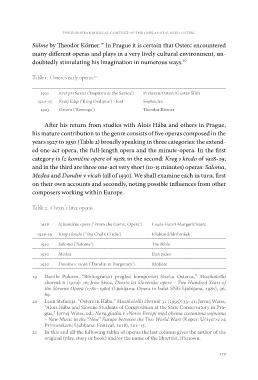Page 381 - Weiss, Jernej, ur. 2019. Vloga nacionalnih opernih gledališč v 20. in 21. stoletju - The Role of National Opera Houses in the 20th and 21st Centuries. Koper/Ljubljana: Založba Univerze na Primorskem in Festival Ljubljana. Studia musicologica Labacensia, 3
P. 381
the european musical context of the oper as of slavko osterc
Sühne by Theodor Körner.19 In Prague it is certain that Osterc encountered
many different operas and plays in a very lively cultural environment, un-
doubtedly stimulating his imagination in numerous ways.20
Table 1: Osterc’s early operas.21
1921 Krst pri Savici (‘Baptism at the Savica’) Prešeren/Osterc/Gustav Šilih
1922-25 Kralj Edip (‘King Oedipus’) - lost Sophocles
Osveta (‘Revenge’) Theodor Körner
1923
After his return from studies with Alois Hába and others in Prague,
his mature contribution to the genre consists of five operas composed in the
years 1927 to 1930 (Table 2) broadly speaking in three categories: the extend-
ed one-act opera, the full-length opera and the minute-opera. In the first
category is Iz komične opere of 1928; in the second: Krog s kredo of 1928-29;
and in the third are three one-act very short (10-15 minutes) operas: Saloma,
Medea and Dandin v vicah (all of 1930). We shall examine each in turn, first
on their own accounts and secondly, noting possible influences from other
composers working within Europe.
Table 2: Osterc’s later operas.
1928 Iz komične opere (‘From the Comic Opera’) Louis-Henri Murger/Osterc
1928-29 Krog s kredo (‘The Chalk Circle’) Klabund/Skrbinšek
Saloma (‘Salome’) The Bible
1930 Medea Euripides
1930 Dandin v vicah (‘Dandin in Purgatory’) Molière
1930
19 Danilo Pokorn, “Bibliografski pregled kompozicij Slavka Osterca,” Muzikološki
zbornik 6 (1970): 76; Jože Sivec, Dvesto let Slovenske opere – Two Hundred Years of
the Slovene Opera (1780–1980) (Ljubljana: Opera in balet SNG Ljubljana, 1981), 36,
89.
20 Leon Stefanija, “Osterc in Hába,” Muzikološki zbornik 31 (1995): 33–41; Jernej Weiss,
“Alois Hába and Slovene Students of Composition at the State Conservatory in Pra-
gue,” Jernej Weiss, ed., Nova glasba v »Novi« Evropi med obema svetonima vojnama
– New Music in the “New” Europe between the Two World Wars (Koper: Univerze za
Primorskem; Ljubljana: Festival, 2018), 201–15.
21 In this and all the following tables of operas the last column gives the author of the
original (play, story or book) and/or the name of the librettist, if known.
379
Sühne by Theodor Körner.19 In Prague it is certain that Osterc encountered
many different operas and plays in a very lively cultural environment, un-
doubtedly stimulating his imagination in numerous ways.20
Table 1: Osterc’s early operas.21
1921 Krst pri Savici (‘Baptism at the Savica’) Prešeren/Osterc/Gustav Šilih
1922-25 Kralj Edip (‘King Oedipus’) - lost Sophocles
Osveta (‘Revenge’) Theodor Körner
1923
After his return from studies with Alois Hába and others in Prague,
his mature contribution to the genre consists of five operas composed in the
years 1927 to 1930 (Table 2) broadly speaking in three categories: the extend-
ed one-act opera, the full-length opera and the minute-opera. In the first
category is Iz komične opere of 1928; in the second: Krog s kredo of 1928-29;
and in the third are three one-act very short (10-15 minutes) operas: Saloma,
Medea and Dandin v vicah (all of 1930). We shall examine each in turn, first
on their own accounts and secondly, noting possible influences from other
composers working within Europe.
Table 2: Osterc’s later operas.
1928 Iz komične opere (‘From the Comic Opera’) Louis-Henri Murger/Osterc
1928-29 Krog s kredo (‘The Chalk Circle’) Klabund/Skrbinšek
Saloma (‘Salome’) The Bible
1930 Medea Euripides
1930 Dandin v vicah (‘Dandin in Purgatory’) Molière
1930
19 Danilo Pokorn, “Bibliografski pregled kompozicij Slavka Osterca,” Muzikološki
zbornik 6 (1970): 76; Jože Sivec, Dvesto let Slovenske opere – Two Hundred Years of
the Slovene Opera (1780–1980) (Ljubljana: Opera in balet SNG Ljubljana, 1981), 36,
89.
20 Leon Stefanija, “Osterc in Hába,” Muzikološki zbornik 31 (1995): 33–41; Jernej Weiss,
“Alois Hába and Slovene Students of Composition at the State Conservatory in Pra-
gue,” Jernej Weiss, ed., Nova glasba v »Novi« Evropi med obema svetonima vojnama
– New Music in the “New” Europe between the Two World Wars (Koper: Univerze za
Primorskem; Ljubljana: Festival, 2018), 201–15.
21 In this and all the following tables of operas the last column gives the author of the
original (play, story or book) and/or the name of the librettist, if known.
379


